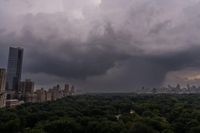On Thursday, July 31, 2025, a fierce storm system unleashed torrential rains and severe thunderstorms across the Mid-Atlantic and Northeast, drenching millions and causing widespread disruption. From South Jersey to New York City and parts of Maryland, the downpours brought flash flooding, transportation chaos, and even tragedy, marking the second bout of intense storms to hit the region in just two weeks.
In South Jersey, the National Weather Service reported an astonishing 6 inches of rain in Pemberton Township’s Browns Mills section by 5:10 p.m. Further measurements showed 3.41 inches in Bridgeton, 3 inches in Atlantic City, 2.73 inches in Logan, and 2.43 inches in Cape May Point. Mount Laurel recorded 2.73 inches by early morning Friday. Other areas like Washington Township, Voorhees, and Waterford saw rainfall between 1.1 and 3.3 inches. The Cohansey River in Hopewell, Cumberland County, rose to flood stage by late evening, signaling the intensity of the weather.
Flash flooding was particularly severe near the Jersey Shore, with roads rendered impassable in Atlantic City, Ocean City, and Somers Point by 7 p.m. The Atlantic City Expressway’s eastbound lane and shoulder closed in Egg Harbor Township due to water accumulation. Social media posts showed residential streets in Absecon flooded with one to two feet of water, and yards also submerged. Near Camden’s Waterfront, Delaware Avenue flooded between Market and Cooper streets, stranding a vehicle around 3:45 p.m.
Earlier that afternoon, parts of South Jersey were under a tornado warning issued by the Weather Service office in Westampton, covering Glassboro, Pitman, and Clayton, though no tornadoes were ultimately reported.
Meanwhile, New York and the broader Northeast braced for the storm’s impact with states of emergency declared in both New York and New Jersey. Governor Kathy Hochul urged residents to remain vigilant, stating, “I am urging all New Yorkers to stay vigilant, stay informed, and use caution as we expect excessive rainfall with the potential for flash flooding.” She assured that state agencies were on standby to monitor and respond in real-time to ensure public safety.
The storm’s effects rippled through the region’s transportation networks. Hundreds of flights at Newark, LaGuardia, and JFK airports were delayed or canceled, with average inbound delays reaching up to three and a half hours at JFK and Newark. The Long Island Rail Road’s Port Washington branch suspended service due to flooding east of Flushing Main Street, and subway lines including the A, D, E, B, F, C, and Q trains faced delays and partial suspensions. The New York Police Department closed all northbound lanes on the FDR Drive at East Houston Street and the southbound lanes of the Cross Island Parkway at the Throggs Neck Bridge. In Queens, the Clearview Expressway was shut down in both directions at Northern Boulevard after videos showed cars submerged in deep water.
One harrowing tragedy struck in Mount Airy, Maryland, where a child was trapped in a storm drain after being swept away by floodwaters. Carroll County Fire Chief Michael Robinson recounted that 50 first responders worked for nearly an hour to rescue the child, who was pronounced dead at the scene. This somber event underscored the storm’s deadly potential amid the widespread flooding.
New York City Mayor Eric Adams declared a localized state of emergency just before 5 p.m., urging residents to avoid unnecessary travel and warning those living in basement apartments to seek higher ground immediately. “Don’t drive. Roadways are flooding, and crews are responding,” Adams said. The emergency declaration was set to last until 8 a.m. the following day.
Flooding in New York was extensive. The highest recorded flood depth citywide was 21.3 inches at Catherine Court and Jewett Avenue on Staten Island. Brooklyn saw water levels of 9.3 inches at Ditmas Avenue and Westminster Road and 8.1 inches in the Wingate neighborhood. Traffic cameras captured scenes of severe flooding on the Clearview Expressway in Queens, where a car was submerged nearly to its roof. Emergency responders rescued stranded motorists from submerged vehicles, including a semi-truck passenger who was helped to safety.
Commuters faced a nightmare. Actor Joon Choi described his usual 30-minute commute extending to two and a half hours due to train cancellations and exorbitant ride-share fares soaring to $400 from the typical $60. Many travelers were stranded as mass transit and highway systems buckled under the storm’s weight.
In Maryland and Washington, D.C., up to four inches of rain had fallen by late afternoon, prompting flash flood warnings and gusts up to 70 mph. Authorities closed flood-prone roads, schools, and libraries early and opened emergency shelters. Airports including Ronald Reagan Washington National and Baltimore/Washington International issued ground stops, causing flight delays averaging over four hours at DCA for incoming flights.
Despite the widespread disruption, some areas like Baltimore saw the storms pass without serious incident, with water taxis resuming service by early evening and flood-prone streets showing minimal standing water.
The meteorological explanation for the deluge was a slow-moving cold front interacting with unusually warm, humid, and unstable air masses, creating intense rainfall rates sometimes exceeding two inches per hour—three times the threshold at which New York City subways typically begin to flood. The Weather Prediction Center issued a Level 3 out of 4 risk for excessive rainfall across a broad swath from Washington to southern New England, warning that some locations might receive over five inches of rain.
In the aftermath, the National Weather Service lifted severe thunderstorm watches for southeastern Pennsylvania, New Jersey, Delaware, and parts of Maryland by 8 p.m., though flood watches remained in effect in some areas. The region was expected to see drier and cooler conditions on Friday, offering a respite from the oppressive heat waves and relentless storms of recent weeks.
This latest storm event highlights the growing challenges posed by extreme weather, which experts link to climate change. As the atmosphere warms, it can hold more moisture—about 3% to 4% more for every degree Fahrenheit increase—leading to heavier rainfall and increased flood risks. The Northeast and Midwest have seen intensifying extreme precipitation over the past six decades, making events like these more frequent and severe.
As communities recover and assess damages, officials continue to urge caution and preparedness, emphasizing the importance of heeding warnings and avoiding flooded areas. The storms of July 31, 2025, serve as a stark reminder of nature’s power and the pressing need to adapt infrastructure and emergency response to a changing climate.





